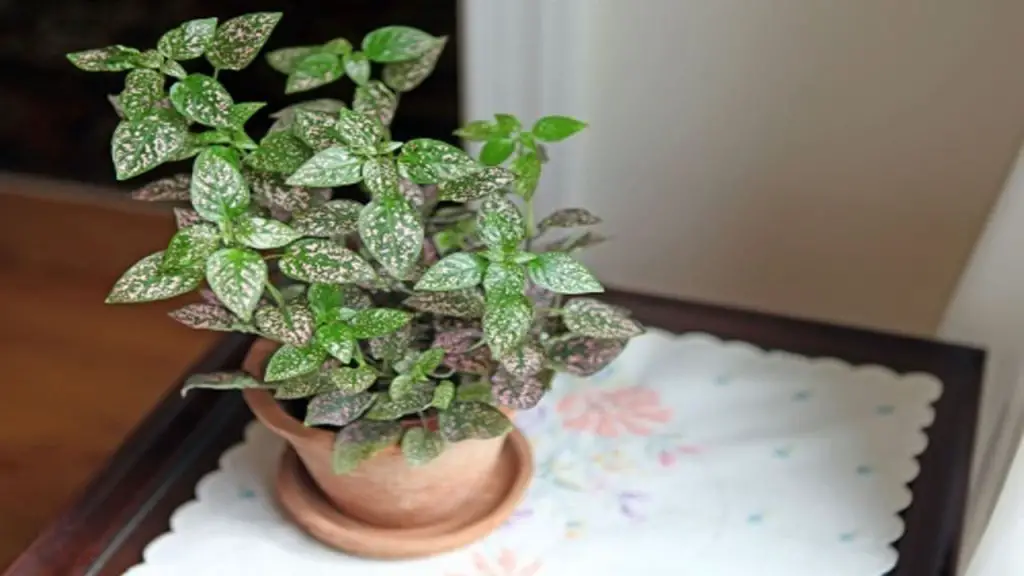Polka dot plants, also known as Hypoestes phyllostachya, are popular indoor plants appreciated for their vibrant, spotted foliage. They are easy to take care of, making them an excellent choice for anyone who wants to add some color to their home or office.
These plants require regular watering, bright but indirect sunlight, and occasional fertilization to stay healthy and happy. If you are looking to add a touch of nature to your living space, a polka-dot plant is a great choice.
In this blog post, we will discuss taking care of your polka dot plant, such as proper watering, lighting, fertilizing, and pruning techniques.
We will also discuss selecting the appropriate type of polka dot plant that will thrive in your environment, as well as common issues that may arise and how to resolve them, and including information on how to propagate your polka dot plant.
So let’s begin by exploring the choosing right types of polka dots best fit your space.
1. How do you Choose the right types of polka dots
1.1 Consider the color
There are several colors available, such as pink, white, and red, which come in different spot patterns.
Consider the color of your room and choose a polka-dot plant that complements it. For instance, a pink-spotted plant might look great in a room with pink accents.
1.2 Look at the leaf size and shape
Polka dot plants come in different leaf sizes and shapes. Some have small, delicate leaves, while others have larger, more robust leaves.
When choosing the size and shape of leaves, take into account the available space and the desired aesthetic outcome.
1.3 Choose the right growth habit
Polka dot plants are available in both standard and dwarf sizes. The dwarf varieties are smaller with a dense, bushy growth pattern, while the standard varieties are taller and have a more open growth pattern.
When choosing the growth habit of your polka dot plant, it’s important to consider the available space and the desired aesthetic outcome.
1.4 Consider the care requirements
Different types of polka dot plants have different care requirements. Some require more sunlight, while others prefer shade. Some need more water, while others are drought-tolerant.
Make sure to research the care requirements of the specific polka dot plant you’re interested in and make sure you’re able to provide the right care.
2. How to Keep Your Polka Dot Plant Healthy and Thriving
In the following paragraphs, we will discuss some essential tips for maintaining a healthy and thriving polka dot plant.

2.1 Watering
Polka dot plants need a regular supply of moisture to stay healthy and happy. It’s crucial to keep the soil moist but not waterlogged as over-watering can cause root rot and other problems.
A general rule of thumb is to water the plant when the top inch of soil feels dry to the touch. You can use your finger to test the soil moisture level or invest in a moisture meter to help you determine when it’s time to water.
When watering, make sure to saturate the soil thoroughly to ensure all roots get the moisture they need. Remember that every environment is different, so you may need to adjust your watering schedule based on your plant’s specific needs.
2.2 Light Requirements
Polka dot plants prefer bright, indirect light. They can tolerate some direct sunlight, but too much can cause the leaves to scorch. If you notice that the leaves are turning yellow or brown, it could be a sign that the plant is getting too much direct sunlight.
On the other hand, if the plant isn’t getting enough light, it may become leggy and lose its vibrant colors. If you’re not sure whether your plant is getting enough light, look for signs like stunted growth, pale leaves, or leggy stems.
To provide the right amount of light for your polka dot plant, place it near a window that gets bright, indirect light. You can also supplement with artificial light if necessary.
2.3 Fertilizing
Just like us, plants need nutrients to stay healthy and grow well. During the growing season, which is typically in the spring and summer, you should fertilize your plant once a month.
When choosing a fertilizer for your polka dot plant, look for a balanced, water-soluble formula that contains equal parts of nitrogen, phosphorus, and potassium. Follow the instructions on the package carefully, as over-fertilizing can damage the plant.
Applying fertilizer is easy. Simply mix the recommended amount of fertilizer with water and apply it to the soil around the base of the plant. You can use a watering can or spray bottle to do this.
Fertilizing your polka dot plant regularly will help it grow strong and healthy, and produce more vibrant foliage. Just remember to follow the instructions on the package and avoid over-fertilizing, which can do more harm than good.
2.4 Humidity
Humidity is an important factor to consider, as polka dot plants prefer high levels of moisture in the air. However, this can be difficult to maintain in indoor environments where the air is often dry.
One way to increase humidity around your plant is to mist the leaves regularly with a spray bottle filled with water. This will help to keep the leaves moist and create a more humid environment for the plant.
Another option is to place the pot on a tray filled with pebbles and water. The water will create humidity as it evaporates, but it’s important to make sure that the bottom of the pot isn’t submerged in water, as this can lead to root rot.
You can also consider using a humidifier to increase the overall humidity in the room, which will benefit not only your polka dot plant but also other indoor plants and even your own health.
2.5 Pruning
Pruning is an essential part of plant care, as it helps to promote healthy growth and keeps the plant looking neat and tidy. To prune your polka dot plant, you’ll need a clean pair of scissors or pruning shears.
Look for stems that are getting too long or have become straggly, and use the scissors to make a clean cut just above a leaf node. This will encourage the plant to produce new growth at the node and promote bushier growth overall.
You can also remove any yellowing or damaged leaves, as these can be a sign of a problem with the plant. Make sure to dispose of any pruned material carefully, as it can harbor pests or diseases. It’s important to prune your polka dot plant regularly to prevent it from becoming too leggy or unruly.
2.6 Temperature
As with most plants, they have specific temperature requirements that are necessary for their growth and overall health.
Polka dot plants prefer to be kept in temperatures between 60 and 80 degrees Fahrenheit. They are sensitive to extreme heat or cold, so it’s best to avoid placing them near radiators, air conditioning units, or drafty windows.
If the temperature drops below 60 degrees, it can cause damage to the plant, while temperatures above 80 degrees can cause the leaves to wilt.
It’s also important to keep in mind that sudden temperature changes can be harmful to the plant. For example, if you move your polka dot plant from a warm room to a cold room too quickly, it can cause shock and damage to the plant.
Similarly, if you move the plant from a cool room to a hot room, it can cause the leaves to droop and become discolored. This will help the plant to thrive and prevent any temperature-related issues from arising.
2.7 Soil
Soil provides essential nutrients and a stable base for the plant’s roots. Polka dot plants prefer to be grown in well-draining, peat-based soil.
This type of soil is lightweight and allows for water to drain easily, which helps to prevent waterlogged roots that can lead to root rot. Heavy, clay-based soil should be avoided as it can retain too much water and suffocate the roots.
If you find that your polka dot plant’s soil is not draining well, you can add perlite or vermiculite to the soil mix. These materials improve drainage by creating air pockets in the soil, which allows for better water flow.
The soil should be kept consistently moist, but not overly wet. Overwatering can lead to root rot and other issues, so make sure to only water the plant when the top inch of soil feels dry to the touch.
3. Common problems and solutions for polka dot plants
3.1 Yellowing Leaves
Yellowing leaves are a common problem for polka dot plants and can be caused by overwatering, underwatering, or exposure to cold temperatures. To fix this issue, make sure you are watering your plant appropriately and keep it in a warm spot away from drafts.
If the yellowing leaves persist, you may need to trim them off and adjust your watering routine.
3.2 Root Rot
Root rot is a fungal disease that can affect polka dot plants if they are overwatered or planted in poorly-draining soil. Signs of root rot include brown or black roots that feel mushy to the touch.
To treat root rot, remove the affected parts of the plant and replant it in fresh soil with good drainage. Avoid overwatering in the future.
3.3 Pests
Polka dot plants are occasionally bothered by pests such as spider mites or mealybugs. You may notice these pests as small, web-like structures or cottony masses on the plant.
To treat pests, gently wipe the leaves with a damp cloth or spray the plant with a solution of water and dish soap. For more severe infestations, you may need to use an insecticidal soap or neem oil.
3.4 Leggy Growth
If your polka dot plant is growing tall and leggy, it may not be getting enough light. Try moving it to a brighter spot with indirect light. You can also pinch back the stems to encourage bushier growth.
3.5 Wilting
Wilting can be caused by a variety of factors, including underwatering, overwatering, or exposure to extreme temperatures.
To fix this issue, make sure you are watering your plant appropriately and keeping it in a suitable environment. You can also try misting the leaves to increase humidity around the plant.
By being aware of these common problems and taking action early, you can help your polka dot plant stay healthy and vibrant. With the right care, your polka dot plant will continue to be a beautiful addition to your indoor garden.
4. How to propagate a polka dot plant
There are two main methods for propagating a polka dot plant: Stem Cuttings and Division
4.1 Stem Cuttings
Stem cuttings are a simple and effective way to propagate a polka dot plant. Below we have discussed how to do it
- Choose a healthy stem from your polka dot plant that is at least a few inches long and has several leaves.
- Use a clean pair of scissors or pruning shears to make a clean cut just below a leaf node (where the leaf attaches to the stem).
- Remove any leaves from the bottom half of the stem, leaving only a few at the top.
- Dip the cut end of the stem into rooting hormone (optional) and then place it in a small pot filled with moist, well-draining soil.
- Cover the pot with a plastic bag or clear plastic wrap to create a humid environment, and place it in a bright but indirect light.
- Keep the soil consistently moist and wait for new growth to appear, which usually takes a few weeks.
- Once the new plant has grown several leaves and roots have formed, and you can transplant it into a larger pot.
4.2 Division
The division is another way to propagate a polka dot plant, and it works best for mature plants that have become too big for their pot. Here’s how to do it:
- Carefully remove the plant from its pot and gently loosen the soil around the roots.
- Look for natural dividing points where the plant has multiple stems coming out from the main root ball.
- Use a clean pair of scissors or pruning shears to carefully separate the plant into two or smaller sections.
- Report each section into a new pot with fresh soil, making sure to keep the soil moist and provide bright but indirect light.
- Wait for new growth to appear before fertilizing the plants.
With these two simple methods, you can easily propagate your polka dot plant and enjoy its beauty for years to come.
Conclusion
In this article, we have explored caring for polka dot plants including choosing the right type of polka dot plant, tackling common problems that may arise, providing effective solutions, and lastly, propagation techniques to ensure your plant flourishes.
We hope that this information is useful to you, and we appreciate you taking the time to read it.
FAQ
Can a polka dot plant be grown indoors or outdoors?
Yes, a polka dot plant can be grown both indoors and outdoors, depending on your climate and preferences. Polka dot plants are versatile and can thrive in a variety of settings.
Indoor polka dot plants can be grown in containers and make great houseplants, while outdoor polka dot plants can be grown in gardens or in containers on patios or balconies.
Just make sure to provide the appropriate lighting, water, soil, and temperature conditions for your polka dot plant to thrive in its particular growing environment.



